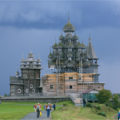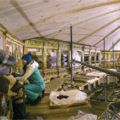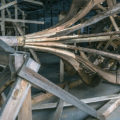30 Years On The World Heritage List
Kizhi Pogost is a unique monument of Russian wooden architecture and one of the most widely recognized architectural masterpieces in the world. It displays remarkable structural harmony, proportionality, and the artistic unity of buildings constructed in different periods of time.
The architectural Ensemble of the Kizhi Pogost is located on a narrow southern spit of the small island of Kizhi, one of the islands of the Kizhi Archipelago in Lake Onega.
The first historical mention of churches on the Kizhi Island dates back to the 16th century. The first churches here had hipped roofs. In 1694, a lightning strike burned them down and in their place churches were built that we see today.
The Architectural Ensemble includes two wooden churches built in the 17th — 18th centuries, a Bell Tower and a fence built in the 19th century.
The Church of the Transfiguration of the Lord is an exceptional monument in terms of its architectural and structural design with no analogues in Russian and world wooden architecture. According to a legend, one master Nestor built it with one ax and without a single nail. The church is a masterpiece of a multi-tiered, multi-domed integral building. Its central dome reaches 37 meters in height. Inside the church, under the vault of the “sky” (a ceiling in the form of a truncated pyramid) there is a gilded carved wooden iconostasis.
Church of the Intercession of the Virgin is made in the traditional type of “octagon on a quadruple” churches. A crown of eight domes surrounds the central dome. This is a warm winter church with traditional four-row iconostasis.
The tall slender Bell Tower with a hipped roof is the latest addition of the Ensemble. The Ensemble is surrounded by a fence with a stone foundation remaining from the old fence of the churchyard. There is an old cemetery inside the fence.
In 1988, at the ICOMOS (National Committee of International Council on Monuments and Sites) meeting in Petrozavodsk, held with the participation of experts from France, Belgium, Great Britain and the USSR, it was recommended to prepare documents for the inclusion of the Architectural Ensemble of the Kizhi Pogost in the UNESCO World Heritage List. In 1989, the Ministry of Culture of the USSR applied to the Kizhi Museum Reserve with a request to prepare nomination documentation. That same year an application was made to include the Kizhi Pogost on the List. In 1990 at the 14th session of the World Heritage Committee three first Russian Sites were added to the List. One of them was Kizhi Pogost.
The most important task ever since has been the preservation of the Architectural Ensemble. In the first place — Church of the Transfiguration, which was in an extremely poor condition. After the recognition of the church in disrepair in 1980, numerous restoration concepts and projects have been discussed for 20 years. Only in 2001, a draft design of stage-by-stage restoration was finally adopted. Over the next 10 years, the issue of adding the Kizhi Pogost to the List of World Heritage in Danger was discussed several times. In 2010, a joint World Heritage Center / ICOMOS Reactive Monitoring Mission arrived at the Site and developed a list of corrective measures not only for restoration, but also for site management and protection.
The long-term restoration of the Church of the Transfiguration of the Lord at the Kizhi Pogost was completed in 2020. The work on the restoration of interior furnishing and decoration has been completed, the gilded carved iconostasis has been recreated. Currently the Church of the Intercession of the Virgin is being prepared for restoration, because its condition is also considered to be very poor.
Since 2014, an Educational and Methodological Center for the Preservation of Wooden Architecture Monuments has been operating in the Museum. On the initiative and with the participation of the Museum, the UNESCO Faculty of Study and Preservation of Wooden Architecture was created at the Petrozavodsk State University.
Since 2017, international courses of ICCROM on Preservation and Restoration of Wooden Architecture have been held in the Museum. These results were assessed, and on the instructions of the Ministry of Culture of the Russian Federation, the All-Russian Center for the Preservation of Wooden Architecture was created and began its work to on the basis of the museum in 2020. Over the years, over 400 students and specialists from Russia and 20 other countries have participated in the Museum’s Educational Programs.
As the tasks of the restoration of monuments were being resolved, the issues of management, protection and development began to come to the fore. Kizhi Pogost is in the operational management of the Kizhi Federal State Historical Architectural and Ethnographic Museum Reserve. The Museum became one of the first managers of the World Heritage Site (WHS) in Russia. It had to closely study international requirements in this area, learn to interact with UNESCO and ICOMOS. For this, a special department was created — the Management and Development Service of the World Heritage Site.
In 2014, the Statements of Outstanding Universal Value were developed and approved — a very important document for further progress on the management and development of WHS. In the same year, the Coordination Council for the Management and Development of the Kizhi Pogost began its work. It includes all interested parties: State authorities, local governments, public organizations, scientists and cultural figures, representatives of the local community.
Over the course of several years, on the recommendations of ICOMOS, a Site Management Plan was developed. In 2016, at the initiative of the Museum, a meeting was held at the UNESCO Headquarters in Paris. The negotiations were attended by representatives of the World Heritage Center and ICOMOS, from the Russian side — representatives of the Ministry of Culture and the Ministry of Foreign Affairs of the Russian Federation, as well as the Kizhi Museum Reserve.
The meeting discussed Management Plan and Development Project for the entrance area. The Project provides for the redistribution of anthropogenic load on the territory of Kizhi Island, diverting the main economic load to the maximum distance away from the Heritage Site, improving the quality of tourist reception and living conditions for specialists. Active long-term work, high-quality preparation of all the required documents and openness made it possible to convince UNESCO and ICOMOS. In 2018 Management Plan for 2018–2026 was agreed and approved by all parties involved.
For the Museum, as the manager of the WHS, restoration work of the Kizhi Ensemble and implementation of Development Projects that have been approved by ICOMOS and the World Heritage Center remain relevant. The issues of development of the buffer zone and local community come to the fore. The area presents complex problems typical of remote and hard-to-reach rural settlements. In the buffer zone of the Site, 35 villages have survived, of which only 14 are permanently populated.
For many years the Museum has played a key role in the local area and shares the responsibility for it and its inhabitants in order to preserve historical, cultural and natural heritage that this land is rich in. It helps local residents to preserve wooden buildings in villages, involves them in activities and projects aimed at developing tourism, protecting the environment, restoring traditions and local crafts. It is the Museum Reserve that has to strive to ensure that the interests of local residents and historical villages are taken into account in the General Plan, and to actively participate in resolving many other issues of local importance.
Within the framework of the “Ethno-architecture of Fennoscandia in the 21st century” International Project under Karelia cross-border cooperation program, the current conditions of historical settlements and the local community are being studied. Its problems and opportunities are being identified and new ways of interaction and further development are sought.
The Kizhi Museum Reserve strives to ensure that, in accordance with the Convention, the status of a World Heritage Site is used for the conservation and sustainable development of both the Site and the historical landscape of the buffer zone, support and further improvement of the local community viability.
Olga Titova, Head of the Management and Development Service of the Kizhi Pogost WHS of the Kizhi Museum Reserve




